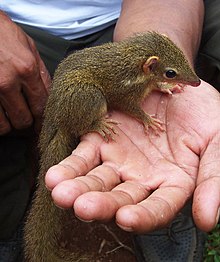Tupaiidae
| Tupaiidae[1] | |
|---|---|

| |
| Tupaia in West Java, Indonesia | |
| Scientific classification | |
| Domain: | Eukaryota |
| Kingdom: | Animalia |
| Phylum: | Chordata |
| Class: | Mammalia |
| Order: | Scandentia |
| Family: | Tupaiidae Gray, 1825 |
| Type genus | |
| Tupaia Raffles, 1821
| |
| Genera | |

| |
| Red: Tupaia, Green: Anathana, Blue: Dendrogale, Purple: both Dendrogale and Tupaia | |
| Synonyms | |
| |
Tupaiidae is one of two families of treeshrews, the other family being Ptilocercidae. The family contains three living genera and 19 living species.[1] The family name derives from tupai, the Malay word for treeshrew and also for squirrel which tupaiids superficially resemble. The former genus Urogale was disbanded in 2011 when the Mindanao treeshrew was moved to Tupaia based on a molecular phylogeny.[4]
Unlike shrews, they possess a fairly large brain for their size. While some research has found treeshrews as the closest living relative to primates, most molecular studies currently find the flying lemurs (colugos) as the sister group to primates despite their gliding specializations.[5]
Taxonomy
[edit]- Genus Anathana
- Madras treeshrew, A. ellioti
- Genus Dendrogale
- Bornean smooth-tailed treeshrew, D. melanura
- Northern smooth-tailed treeshrew, D. murina
- Genus Tupaia
- Northern treeshrew, T. belangeri
- Golden-bellied treeshrew, T. chrysogaster
- Striped treeshrew, T. dorsalis
- Mindanao treeshrew, T. everetti
- Common treeshrew, T. glis
- Slender treeshrew, T. gracilis
- Horsfield's treeshrew, T. javanica
- Long-footed treeshrew, T. longipes
- Pygmy treeshrew, T. minor
- Calamian treeshrew, T. moellendorffi
- Mountain treeshrew, T. montana
- Nicobar treeshrew, T. nicobarica
- Palawan treeshrew, T. palawanensis
- Painted treeshrew, T. picta
- Ruddy treeshrew, T. splendidula
- Large treeshrew, T. tana
Conservation
[edit]A majority of the species, 71.4%, in this family are of least concern, according to the IUCN red list. Nearly a twentieth of the species, 4.8%, are vulnerable and the same number are endangered. 19% of the species have not had enough data collected yet for them to be rated on the scale.[6]
References
[edit]- ^ a b Helgen, K.M. (2005). "Family Tupaiidae". In Wilson, D.E.; Reeder, D.M (eds.). Mammal Species of the World: A Taxonomic and Geographic Reference (3rd ed.). Johns Hopkins University Press. p. 104. ISBN 978-0-8018-8221-0. OCLC 62265494.
- ^ a b Ni, X.; Qiu, Z. (2012). "Tupaiine tree shrews (Scandentia, Mammalia) from the Yuanmou Lufengpithecus locality of Yunnan, China". Swiss Journal of Palaeontology. 131 (1): 51–60. doi:10.1007/s13358-011-0029-0.
- ^ Sehgal, R. K.; Singh, A. P.; Gilbert, C. C.; Patel, B. A.; Campisano, C. J.; Selig, K. R.; Patnaik, R.; Singh, N. P. (2022). "A new genus of treeshrew and other micromammals from the middle Miocene hominoid locality of Ramnagar, Udhampur District, Jammu and Kashmir, India". Journal of Paleontology: 1–18. doi:10.1017/jpa.2022.41.
- ^ Roberts, T.E.; Lanier, H.C.; Sargis, E.J.; Olson, L.E. (2011). "Molecular phylogeny of treeshrews (Mammalia: Scandentia) and the timescale of diversification in Southeast Asia". Molecular Phylogenetics and Evolution. 60 (3): 358–372. doi:10.1016/j.ympev.2011.04.021. PMID 21565274.
- ^ Janecka, Jan E.; Miller, Webb; Pringle, Thomas H.; Wiens, Frank; Zitzmann, Annette; Helgen, Kristofer M.; Springer, Mark S.; Murphy, William J. (2007). "Molecular and genomic data identify the closest living relative of the primates". Science. 318 (5851): 792–794. Bibcode:2007Sci...318..792J. doi:10.1126/science.1147555. PMID 17975064. S2CID 12251814.
- ^ "The IUCN Red List of Threatened Species".





